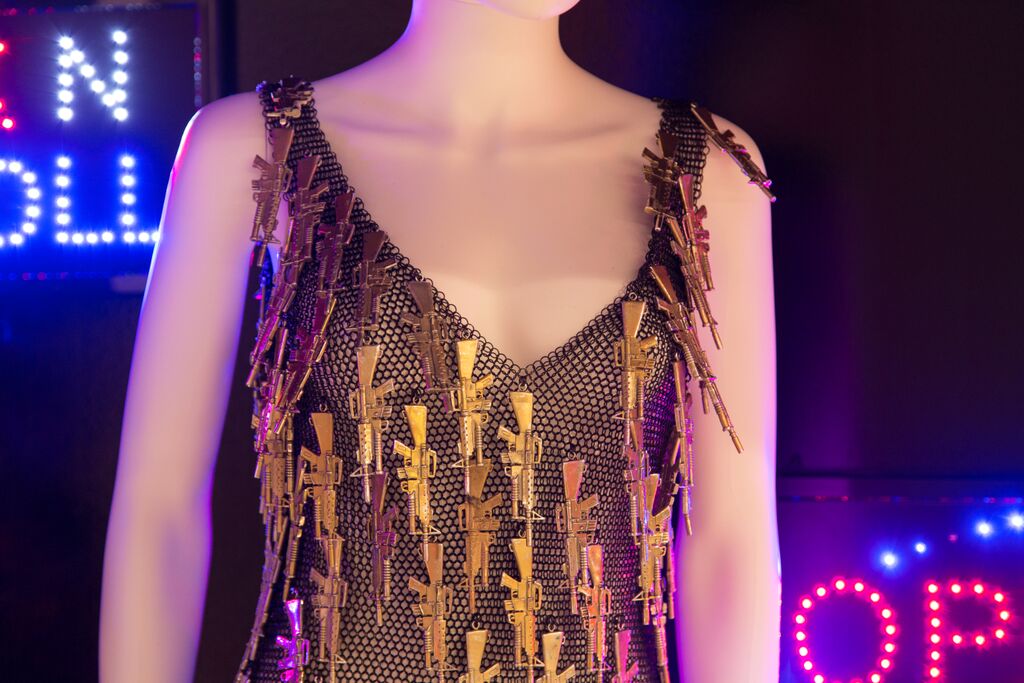Deeper than beauty: the politics of fashion
I recently visited Design Exchange’s (DX) Politics of Fashion | Fashion of Politics exhibit. Fashion and politics is an unlikely combination for many. However, when considering the display of runway feminism, the overlap is more prevalent than perceived. The DX exhibit aims to take the often trivialized fashion industry and examine how it intersects with politics, which then influences our everyday lives and vice versa. Beyond the clothes, styles and trends, fashion is an active agent in creating and perpetuating the many complicated social relations of our world.
The exhibit is laid out in sections in an attempt to organize and label the different ways politics are understood. “Ethics and Activism” contains displays on FEMEN and PETA, alongside a Nick Knight short film on racism in the industry. The film stars Naomi Campbell, an iconic black model who herself has spoken against racism in the fashion industry, particularly concerning the underrepresentation of black models. Nick Knight is a white British photographer who in this film voices his disgust with fashion’s racism and his refusal to ignore it. He displays Naomi armed with a machine gun, shooting with indignation and laughter — perhaps at fashion’s racists. However, Naomi Campbell did not walk in Chanel’s SS’15 show and in fact, only 4 of the 86 models present were black, and only 14 of them (16%) were non-white. Considering how Chanel’s creative director Karl Lagerfeld chose to organize the show around the strength of feminism, it is concerning that the feminism is not consistent within all races. There are social consequences to the power Lagerfeld holds in directing a major fashion house like Chanel and co-opting feminism in this non-diverse way. Nick Knight’s film came out in 2008, and 6 years later the numbers prove that nothing has changed.
Similar to the way Lagerfeld has co-opted feminism and decontextualized it for the sake of fashion, other brands often take significant cultural artifacts and erase their origins, labelling them as “trends.” We often see stores labelling certain prints as ‘tribal,’ in which generic shorts, dresses, pants and crop tops are presented ready for purchase- never naming which ‘tribe’ the company is erasing and profiting from. In Rick Owens’ Fall/Winter 2014 menswear show, some of the models wore headwear which style.com describes as “cashmere head wraps that symbolized benevolent nuns.” However, as Complex magazine notes, these look strangely more like du-rags, emblematic of black fashion and seen worn by rappers like 50 Cent. Fashion is notoriously guilty of refusing to cite its sources.
The “Gender and Sexuality” section holds the salmon Jean Paul Gaultier bustier dress (1988) that became the source of Madonna’s look for her Blond Ambition tour (1990). The dress allows us to examine the history behind Madonna’s insistence on a new brand of femininity and women’s sexuality by chronicling her constant reinvention of what she believed was the standard. The use of fashion in this sense was her way of expressing her identity while also allowing fashion to creep into pop culture. On a larger scale, it addresses fashion’s potential as a method of personal expression and identity performance for everyone. We can explore and express our identities in the forms we choose to dress – fashion gives us an opportunity to be read and understood. The JPG dress also speaks to the legacy of fashion and the power it holds to extend into popular culture.
There’s a scene in The Devil Wears Prada where Andy (Anne Hathaway) scoffs at two blue belts the editorial team is trying to choose between: “It’s just that both those belts look exactly the same to me.” Miranda Priestly (Meryl Streep) turns to her, offended, and challenges Andy about what she thinks she knows about the fashion industry. She responds, “you think this has nothing to do with you. You go to your closet and you select… that lumpy blue sweater [..] But what you don’t know is [..] that blue represents millions of dollars and countless jobs… you’re wearing the sweater that was selected for you by the people in this room from a pile of ‘stuff.’”
I can’t do justice to Streep’s acting on paper, but the movie asks us to question what we think we know about fashion, our world, and ourselves. Politics of Fashion does the same and we must remember every item of clothing, magazine and runway show is laced with meaning and politic. The clothes hanging in our closet and laying on our floor can tell stories, often of ourselves but sometimes more complicated ones, beyond aesthetics and vanity.
Featured image courtesy of the Design Exchange
